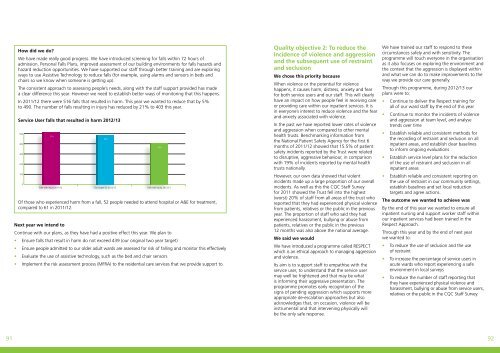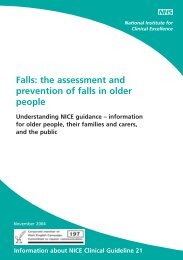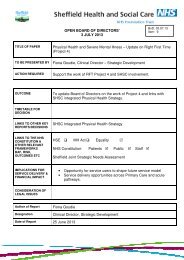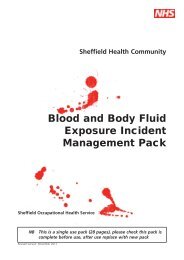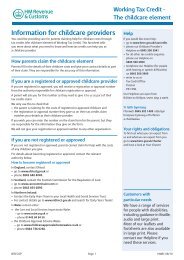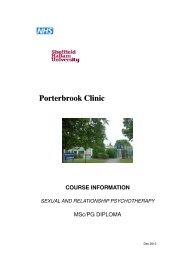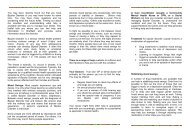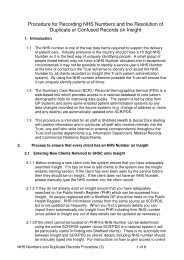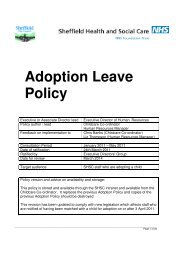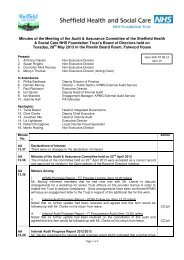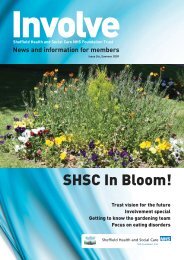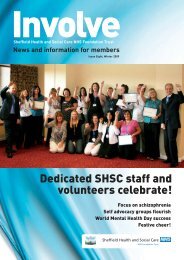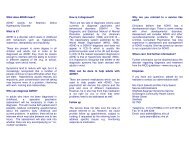Item 8 - Sheffield Health and Social Care
Item 8 - Sheffield Health and Social Care
Item 8 - Sheffield Health and Social Care
Create successful ePaper yourself
Turn your PDF publications into a flip-book with our unique Google optimized e-Paper software.
How did we do?We have made really good progress. We have introduced screening for falls within 72 hours ofadmission, Personal Falls Plans, improved assessment of our building environments for falls hazards <strong>and</strong>hazard reduction opportunities. We have supported our staff through better training <strong>and</strong> are exploringways to use Assistive Technology to reduce falls (for example, using alarms <strong>and</strong> sensors in beds <strong>and</strong>chairs so we know when someone is getting up).The consistent approach to assessing people’s needs, along with the staff support provided has madea clear difference this year. However we need to establish better ways of monitoring that this happens.In 2011/12 there were 516 falls that resulted in harm. This year we wanted to reduce that by 5%to 490. The number of falls resulting in injury has reduced by 21% to 403 this year.Service User falls that resulted in harm 2012/135004003002001000516490Falls with injury 2011/12 Our target for 2012/13Falls with injury 2012/13Of those who experienced harm from a fall, 52 people needed to attend hospital or A&E for treatment,compared to 61 in 2011/12.Next year we intend toContinue with our plans, as they have had a positive effect this year. We plan to• Ensure falls that result in harm do not exceed 439 (our original two year target)• Ensure people admitted to our older adult wards are assessed for risk of falling <strong>and</strong> monitor this effectively• Evaluate the use of assistive technology, such as the bed <strong>and</strong> chair sensors• Implement the risk assessment process (MFRA) to the residential care services that we provide support to.403Quality objective 2: To reduce theincidence of violence <strong>and</strong> aggression<strong>and</strong> the subsequent use of restraint<strong>and</strong> seclusionWe chose this priority becauseWhen violence or the potential for violencehappens, it causes harm, distress, anxiety <strong>and</strong> fearfor both service users <strong>and</strong> our staff. This will clearlyhave an impact on how people feel in receiving careor providing care within our inpatient services. It isin everyone’s interest to reduce violence <strong>and</strong> the fear<strong>and</strong> anxiety associated with violence.In the past we have reported lower rates of violence<strong>and</strong> aggression when compared to other mentalhealth trusts. Benchmarking information fromthe National Patient Safety Agency for the first 6months of 2011/12 showed that 15.5% of patientsafety incidents reported by the Trust were relatedto disruptive, aggressive behaviour, in comparisonwith 19% of incidents reported by mental healthtrusts nationally.However, our own data showed that violentincidents made up a large proportion of our overallincidents. As well as this the CQC Staff Surveyfor 2011 showed the Trust fell into the highest(worst) 20% of staff from all areas of the trust whoreported that they had experienced physical violencefrom patients, relatives or the public in the previousyear. The proportion of staff who said they hadexperienced harassment, bullying or abuse frompatients, relatives or the public in the previous12 months was also above the national average.We said we wouldWe have introduced a programme called RESPECTwhich is an ethical approach to managing aggression<strong>and</strong> violence.Its aim is to support staff to empathise with theservice user, to underst<strong>and</strong> that the service usermay well be frightened <strong>and</strong> that may be whatis informing their aggressive presentation. Theprogramme promotes early recognition of thesigns of pending aggression which supports moreappropriate de-escalation approaches but alsoacknowledges that, on occasion, violence will beinstrumental <strong>and</strong> that intervening physically willbe the only safe response.We have trained our staff to respond to thesecircumstances safely <strong>and</strong> with sensitivity. Theprogramme will touch everyone in the organisationas it also focuses on exploring the environment <strong>and</strong>the context that the aggression is displayed within<strong>and</strong> what we can do to make improvements to theway we provide our care generally.Through this programme, during 2012/13 ourplans were to:• Continue to deliver the Respect training forall of our ward staff by the end of this year• Continue to monitor the incidents of violence<strong>and</strong> aggression at team level, <strong>and</strong> analysetrends over time• Establish reliable <strong>and</strong> consistent methods forthe recording of restraint <strong>and</strong> seclusion on allinpatient areas, <strong>and</strong> establish clear baselinesto inform ongoing evaluations• Establish service level plans for the reductionof the use of restraint <strong>and</strong> seclusion in allinpatient areas• Establish reliable <strong>and</strong> consistent reporting onthe use of restraint in our community settings,establish baselines <strong>and</strong> set local reductiontargets <strong>and</strong> agree actions.The outcome we wanted to achieve wasBy the end of this year we wanted to ensure allinpatient nursing <strong>and</strong> support worker staff withinour inpatient services had been trained in theRespect Approach.Through this year <strong>and</strong> by the end of next yearwe wanted to:• To reduce the use of seclusion <strong>and</strong> the useof restraint• To increase the percentage of service users inacute wards who report experiencing a safeenvironment in local surveys• To reduce the number of staff reporting thatthey have experienced physical violence <strong>and</strong>harassment, bullying or abuse from service users,relatives or the public in the CQC Staff Survey.9192


